
Universidade Fernando Pessoa
Porto, Portugal

Seismic-Sequential Stratigraphy
Discontinuity surfaces are surfaces caused by to erosion or depositional hiatus.

Plate 197 - Unconformities or erosional surfaces can be recognized on the field and seismic lines, below and above strata or reflection terminations. Generally, such a surfaces are induced by relative sea level falls created by the combination of the subsidence, uplift (Tectonics) and eustasy. However, the cyclicity is basically associated with the eustasy.
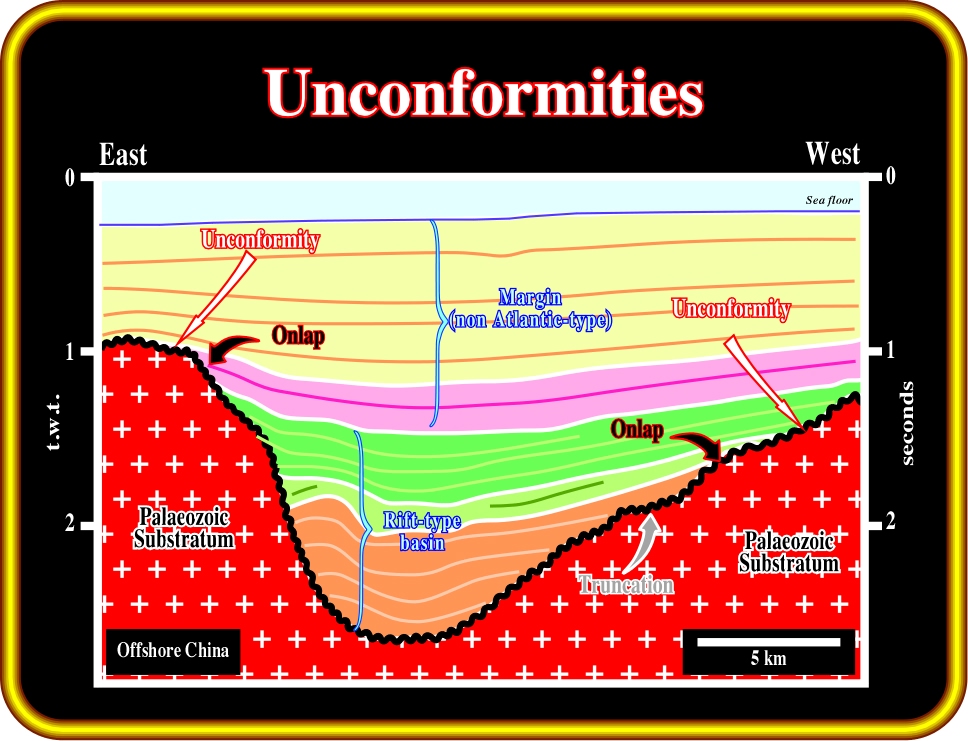
Plate 198 - On this line from offshore China, the major unconformity separating the Paleozoic substratum from the Meso-Cenozoic sediments of the rift-type basin and/or the non-Atlantic type margin (on the eastern part of the line) is overlain by onlap reflection terminations. Such reflection terminations are easily recognized in the lower seismic packages, which have a parallel internal configuration. In spite of the fact that in the rift-type basin nonmarine environments are preponderant, the onlaps indicate successive relative sea level rises.

Plate 199 - The seismic surface illustrated on this seismic line, in white, is quite particular. Indeed, erosion is not evident due tothe concordance between it and the underlying sediments. The sediments overlying it are deep-water sediments (turbidite depositional systems) and the associated reflections terminate in onlap defining a classic onlap seismic surface. Strictly speaking, this onlap seismic surface is not an unconformity, but, as we will see later, it is correlatable updip with an erosional surface, i.e, with an unconformity. Indeed, such a deep-water onlap seismic surface, which locally can show evidence of submarine erosion, bounds stratigraphic cycles (sequence cycles) and is correlatable updip with a subaerial erosional surface (unconformity).
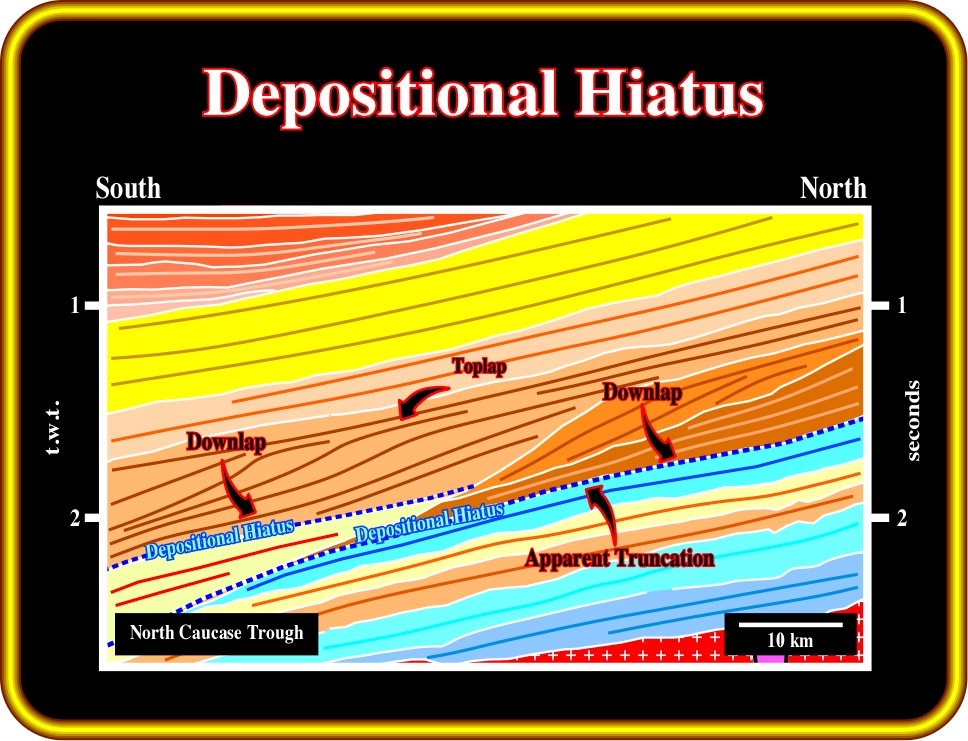
Plate 200 - When submarine deep-water erosion is paramount, asfor example in deep-water of Gulf of Mexico, the associated truncated seismic surfaces are, by definition, unconformities. As illustrated here (North Caucase trough), quite often, deep-water unconformities are often fossilized by onlapping of slope or basin floor fan sediments,

Plate 201- Depositional hiatus are characterized by downlaps with toplap in the upward reflection terminations. However, in certain instances, the interface can be defined by downlaps over apparent truncations or onlaps over a conformable lower sedimentary package.
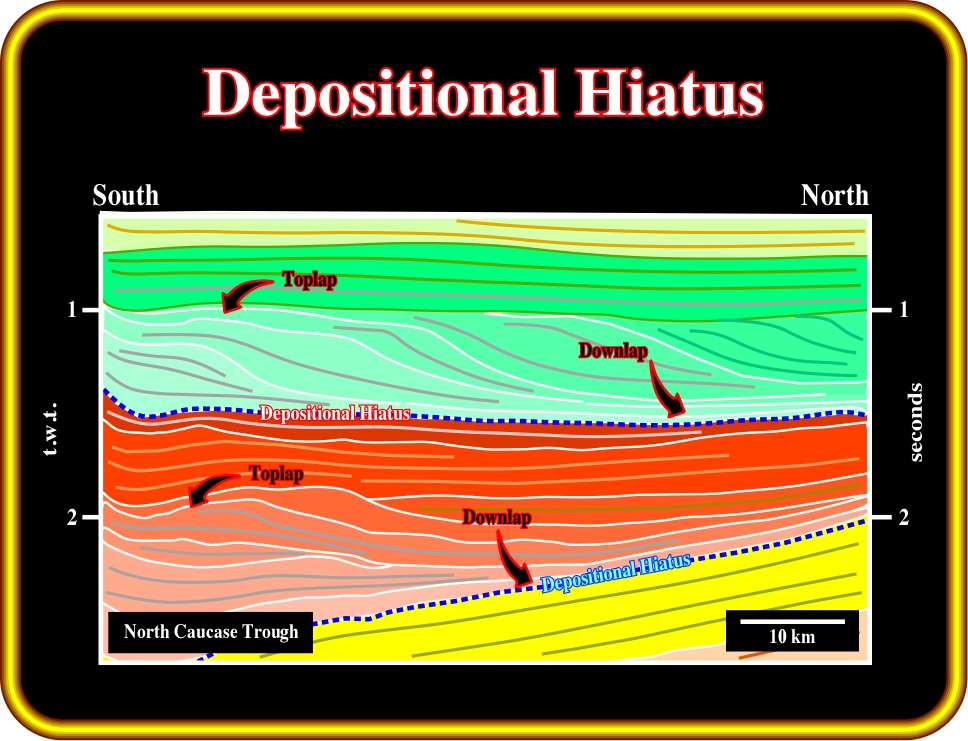
Plate 202 - Two major non-depositional hiatus surfaces (in blue) defined by downlap reflection terminations are quite evident on this seismic line from the North Caucasus trough. These surfaces emphasize the geologic-time interval during which no strata was deposited at the depositional surface. The progradational (forestepping) geometry of the depositional systems implies a progressive fossilization of the depositional surface. Subsequently, the hiatus duration increases seaward, i.e., in the direction of the downlap terminations.

Plate 203 - The lower non-depositional hiatus surface illustrated on this seismic line is more complex than those illustrated on Plate 202. As an aggradational turbidite interval (in light yellow), probably basin floor fans, is recognized on the southern part of the line. The geologic-time during which no strata were deposited on the hiatus surface is more difficult to reckon, since the turbidite deposit can be disconnected from the downlap termination. Immediately after the deposition of the turbidite interval, a depositional hiatus surface was developed on the top of the turbidites, which was later fossilized by downlap terminations.

Plate 204 - Taking into account that erosion is only evident on the apex of the structure (enhanced unconformity), the unconformity on the northern flank can be considered as classic eustatic unconformity. On the northern flank, the hiatus can be considered as a non-depositional hiatus characterized by underlying subaqueous concordant sediments and overlying subaerial (?) onlapping sediments. In the contrary, on the apex of the structure, the hiatus is erosional and refers to the geologic-time range of the strata which was removed by erosion and not the time at which erosion occurred. The shortening of the sediments corresponds to a tectonic inversion, in which older normal faults were reactivated as reverse faults.
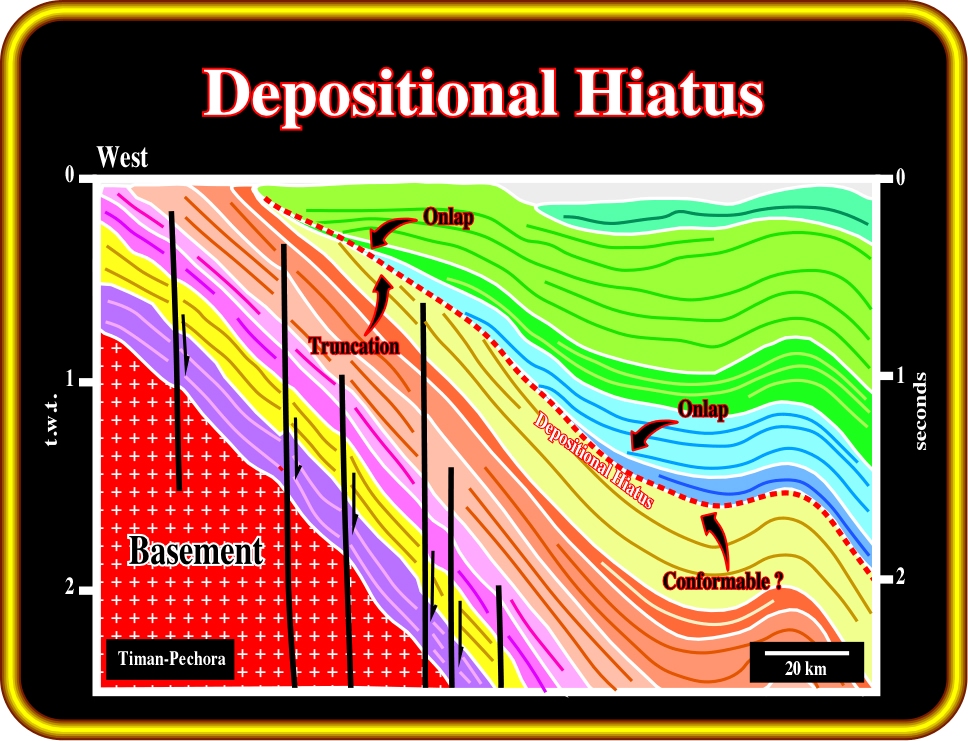
Plate 205 - The hiatus surface recognized on this line (eastern part) can be considered, at least partially, as a non-depositional hiatus surface. Erosion is meaningless. The depositional hiatus surface corresponds to an interface characterized by underlying conformable sediments and overlying onlapping sediments. The upper sediments underlying the depositional surface were significantly eroded. So, the hiatus surface, in this area, must be considered as erosional. Such a surface can be considered as an unconformity or correlatable with an unconformity, i.e., a stratigraphic cycle boundary (see later).
Unconformities
An unconformity is an erosional surface that separates younger strata from older rocks and represents a significant hiatus (at least a correlatable part of a geochronologic unit is not represented by strata). In very particular cases, an unconformity can corresponds to an non-depositional surface. Periods of erosion and non deposition occur at each global fall of sea level producing interregional unconformities. Although in some areas of continuous deposition, the hiatus may be too small to be detected paleontologically or seismically, and the surface is defined as a conformity.

Plate 206 - Two major unconformities, i.e., erosional surfaces characterized by truncation and onlap reflection terminations, are easily recognized on this line. The lower one is the breakup unconformity (BUU). It limits the rift-type sediments from the Atlantic-type margin sediments. The upper one separates the basal fluvio-deltaic sediments of the margin from marine and deep marine sediments. Both unconformities are induced by significant relative sea level changes.
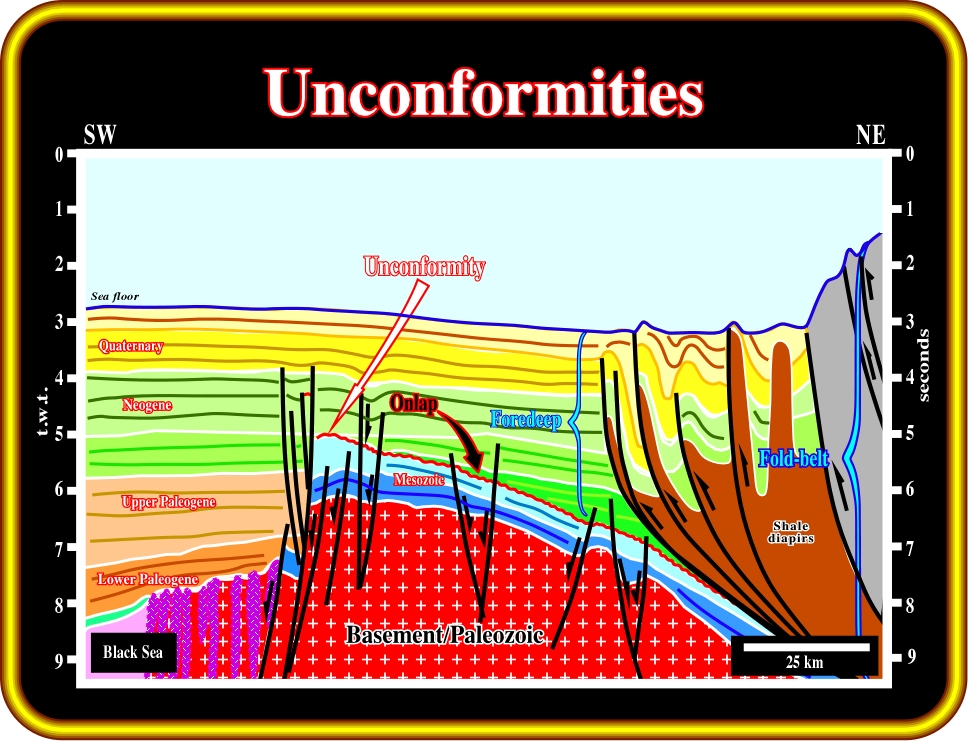
Plate 207 - On this seismic line from the Black Sea, the major unconformity (in red) is mainly tectonically induced. The loading of the thrusts associated with the folded belt seems to be principally responsible for the unconformity (basal foredeep unconformity). In this particular instance, it is emphasized by the onlap reflection terminations of the foredeep sediments. The underlying sediments roughly conform with the unconformity.

Plate 208 - On this line, the upper unconformity is often considered as the breakup unconformity, i.e., the unconformity induced by the breakup of the lithosphere. Some geologists think the unconformity associated with the breakup is the lower unconformity. In spite of the turbiditic nature of the interval bounded by the unconformities, I have a tendency to consider the upper unconformity as the BUU, since differential subsidence (extensional tectonic regime) is much more frequent in rift-type basins. As depicted, the upper erosional surface is underlined by truncation reflection terminations of the seismic reflectors. The margin sediments fossilized the erosional surface by onlapping induced by successive relative sea level rises created by sea floor spreading. The geometric relationships associated with the lower unconformity are more subtle.
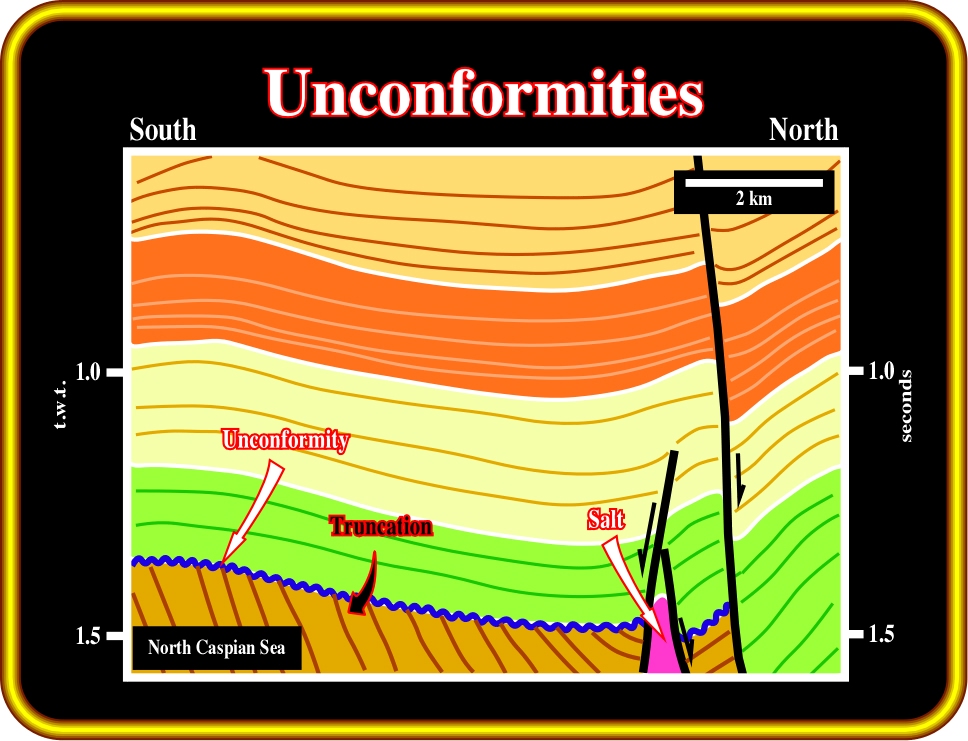
Plate 209 - As we will see in volume III, unconformities are mainly eustatically induced. However, they can be tectonically (halokinesis and shalokinesis included) enhanced. In such a hypothesis, the underlying associated reflection terminations are truncations and the unconformity is often labeled an angular unconformity. On this seismic line, it is quite evident that the picked unconformity was tectonically enhanced. In the North Caspian Sea, and particularly in the area of the Kashagan oil field, halokinesis is paramount. The major geologic consequence of Permian salt (Kungurian salt) flowage was the cause of deformation and uplift of Triassic sediments, which were partially eroded (truncation) before being covered by Jurassic marine sediments.

Plate 210 - Interpreters must differentiate tectonic disharmonies from unconformities (erosional surfaces). Tectonic disharmonies, as depicted above, are décollement surfaces bounding two sedimentary intervals with quite different deformation styles. There is not significant erosion associated with tectonic disharmonies. On the contrary, as stated previously, erosion is a distinguishing characteristics of unconformities. Erosion is mainly subaerial. Submarine erosion is generally localized on the upper slope and associated with gravity currents.

Plate 211 - In salt basins, the evacuation of salt often creates significant tectonic disharmonies. An example from the Kwanza basin (Angola) is illustrated here. This disharmony can be recognized on almost all seismic lines in the basin. As suggested, due to salt flowage, the suprasalt strata is quite deformed, while the infrasalt strata is almost undeformed. The reflection terminations of the suprasalt strata are not pristine. They look like downlaps but actually they are tilted onlaps. It is important to notice that there is not erosion between the infra and suprasalt strata. Such interface cannot be considered as an unconformity. Salt welds were developed where salt expulsion was complete.